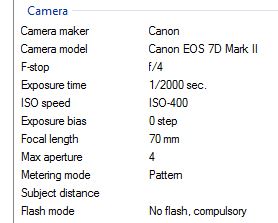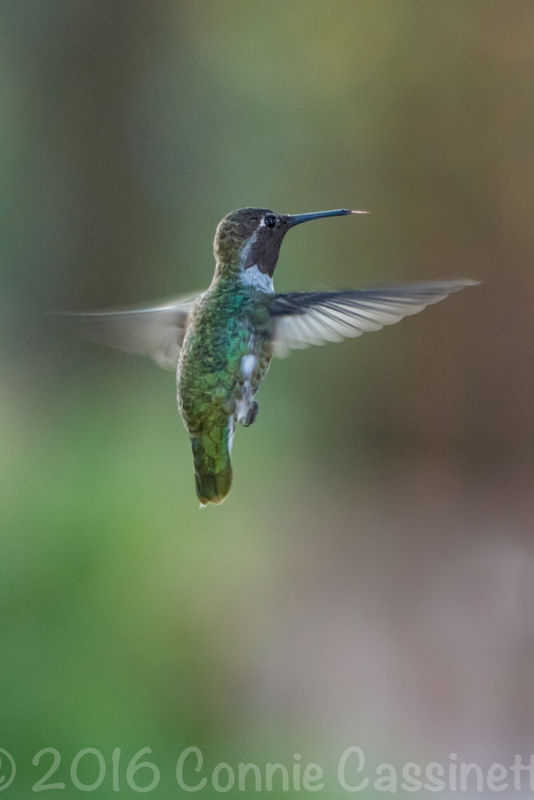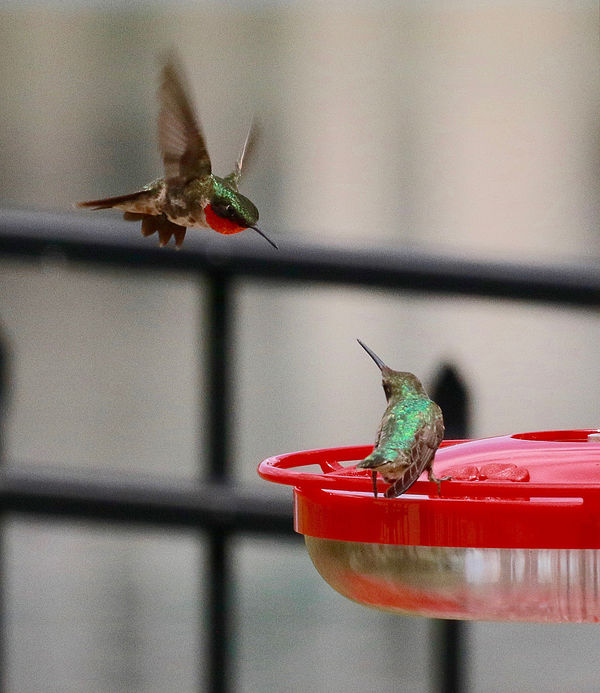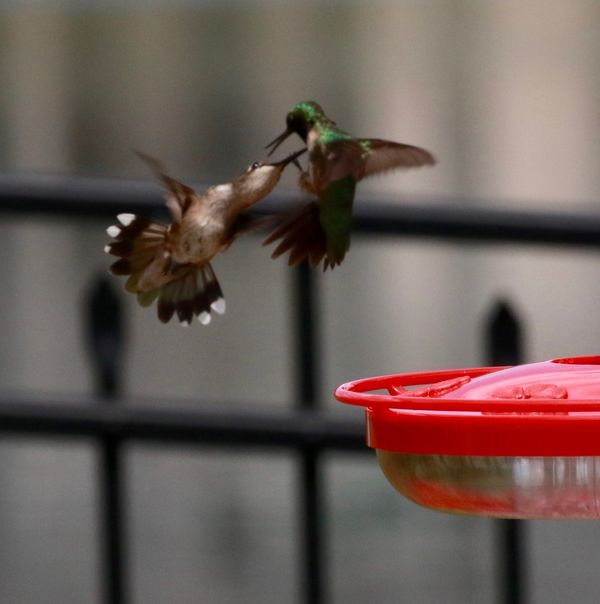Depth of field question
Jul 12, 2016 17:25:22 #
Robert R wrote:
I have been experimenting with hummingbird photos.... (show quote)
It appears you have plenty of light so set your shutter speed to 1/500 or 1/1000. That will freeze the birds in flight. Getting a deep DOF will, of course, require a smaller aperture and also will probably give you hummer blur.
Jul 12, 2016 19:26:53 #
lloydl2 wrote:
The 1/3 in front and 2/3 behind is a generally accepted rule of thumb and is a rough estimate not 100% accurate in all cases
That is a very poor "rule of thumb" to follow. It is only true when the focus distance is roughly about 1/3rd of the hyperfocal distance. At closer focus distances the ratio becomes closer and closer to equally split in front of the focus point and behind the focus point, which is essentially correct for all closeup and macro work. At the hyperfocal distance the in focus area is significantly greater behind the focus point, and it becomes more so as the focus distance is increased (which is most useful to know if shooting landscapes).
Consider a 50mm lens at about f/4.5 and focused at 20 feet. The hyperfocal distance is 60 feet. And because the focus distance is 1/3 the hyperfocal distance there is a 1/3 to 2/3 division front and back for the DOF. But if focus is at 5 feet, rather than a 1:2 ratio it is a 1:1.2 ratio. At a focus distance of 2.5 feet the ratio is 1:1.1 and gets closer to 1:1 at even closer focus distances.
But focused at 60 feet the near distance is 30 feet in front of the focus point, but DOF extends for some 21,500 feet beyond the focus point (a 1:719 ratio!).
Obviously it is pretty hard to find a typical time when the ratio would be 1/3 in front and 2/3 behind the point of focus.
Jul 13, 2016 03:16:09 #
Robert R wrote:
I have been experimenting with hummingbird photos.... (show quote)
If it were me, I'd use manual mode and then that way I'd be in control of all of the elements necessary to get the qualities I'm looking for; depth of field, stopping the wings in motion...etc.
Now that you know what the camera chose and the fact that you need deeper depth of field, you know what to manipulate.
You had:
ISO 400
1/2000
f/4
But it could have just as easily been:
ISO 800
1/2000
f/5.6
Or
ISO 800
1/1000
f/8
As long as when you take away from one of the 3 elements of exposure, you add back to another of the elements; i.e. take away one stop of aperture (from f/4 to f/5.6) then you must give back via shutter speed or ISO (I used ISO from 400 to 800)
To me, it just makes everything much easier to understand and letting the camera drive part of the exposure is like having a steering wheel on the passenger side of the car and you never know when or how much your passenger will give it a yank!
Those are my thoughts.
Jul 13, 2016 16:31:35 #
I would set ISO to 800, 1600, or 3200. And change aperture from F4 to F8 or F11

Jul 13, 2016 16:42:58 #
For what was originally a fairly simple question from the OP on DOF, the UHG sure has complicated the hell out of it.
I wonder which the OP was looking for-- a more simple answer, or a thesis on Hummingbird photography?.
I wonder which the OP was looking for-- a more simple answer, or a thesis on Hummingbird photography?.
Jul 13, 2016 19:04:23 #
Jul 14, 2016 05:49:41 #
JCam wrote:
For what was originally a fairly simple question from the OP on DOF, the UHG sure has complicated the hell out of it.
I wonder which the OP was looking for-- a more simple answer, or a thesis on Hummingbird photography?.
I wonder which the OP was looking for-- a more simple answer, or a thesis on Hummingbird photography?.


Jul 17, 2016 05:45:28 #
ejrmaine wrote:
I'm using a Digital Depth of Field app on my iPhone, using the 70mm focal length, and the 10 ft distance, if you set your aperture to f16 you'd have a depth of field of 3'-8.8" with a near focus distance of 8'-5.7" and a far distance of 12'-2.4".
As was mentioned above, adjust your Shutter speed and or ISO to make f16 work.
Please post the results.
As was mentioned above, adjust your Shutter speed and or ISO to make f16 work.
Please post the results.
I am getting better depth of field. This was at ISO 1000, 1/1600, f13, with Canon 100-400 L 11 at 300 mm., Canon 7D Mark 2. Now I have to work on a better background.
Jul 17, 2016 05:52:14 #
[quote=Robert R]I am getting better depth of field. This was at ISO 1000, 1/1600, f13, with Canon 100-400 L 11 at 300 mm., Canon 7D Mark 2. Now I have to work on a better background. A little argument about who gets to use the feeder.
Jul 17, 2016 07:54:30 #
[quote=Robert R]
Don't forget camera distance to subject also plays a part in DOF, often I'll opt for a bigger lens, if you were to move back, zoom in with a wider aperture, (lower ISO) you can achieve the same exposure, adequate DOF and achieve a better more out of focus background / Bokeh.
Robert R wrote:
I am getting better depth of field. This was at ISO 1000, 1/1600, f13, with Canon 100-400 L 11 at 300 mm., Canon 7D Mark 2. Now I have to work on a better background. A little argument about who gets to use the feeder.
Don't forget camera distance to subject also plays a part in DOF, often I'll opt for a bigger lens, if you were to move back, zoom in with a wider aperture, (lower ISO) you can achieve the same exposure, adequate DOF and achieve a better more out of focus background / Bokeh.
Jul 17, 2016 11:11:21 #
[quote=Robert R]
Robert, Much better! Now increase the shutter speed to freeze the wings and increase the f-stop to maybe f 11 or 8 to compensate for the less light.
Robert R wrote:
I am getting better depth of field. This was at ISO 1000, 1/1600, f13, with Canon 100-400 L 11 at 300 mm., Canon 7D Mark 2. Now I have to work on a better background. A little argument about who gets to use the feeder.
Robert, Much better! Now increase the shutter speed to freeze the wings and increase the f-stop to maybe f 11 or 8 to compensate for the less light.
Jul 17, 2016 11:41:31 #
Thanks. I am away from home for a week, will try when I return. Thanks again.
Aug 6, 2016 13:25:30 #
Robert R wrote:
I have been experimenting with hummingbird photos.... (show quote)
using manual you have complete control of depth of field.. In the semi auto modes you don't. For a shallow depth of field, I suggest using a longer focal length and move up closer if possible and use another lens with a wider aperture. To get a wider depth of field then close down you aperture in Manual mode.
Aug 6, 2016 17:18:22 #
canon Lee wrote:
using manual you have complete control of depth of field.. In the semi auto modes you don't. For a shallow depth of field, I suggest using a longer focal length and move up closer if possible and use another lens with a wider aperture. To get a wider depth of field then close down you aperture in Manual mode.
Why get "another lens with a wider aperture" if it will then be closed down to get a wider DOF?
Stay with the 70-200mm f/4, it will do just fine. But using Shutter Priority (Tv mode) and not a fixed ISO value is what causes the aperture used to be f/4. If Av is used instead it won't really help because then the aperture might be right but the shutter speed will likely be too slow to freeze the motion.
There are several ways to go. One is fully manual, the other is manual exposure and Auto ISO (not all Canon models can do that). But another method is to set the minimum ISO that will be used to something significantly higher than the ISO 400 used. Or just disable Auto ISO and set it manually to a higher value. Again that depends on the camera model as some get too much noise above say ISO 1200 while others are fine at ISO 3200.
Aug 9, 2016 13:17:52 #
Robert R wrote:
I have been experimenting with hummingbird photos.... (show quote)
The first thing is to understand what kind of shot you want, one with the bird in the distance and the feeder in it and everything sort of sharp or one with the hummer close up, away from the feeder, and everything in the background sort of blurred. These shots require different settings. When I've shot hummers I go for the close up of the hummer, using both the camera's tools and my processing software tools, and I use a wide open aperture with the lens set at maximum distance. I try to avoid the feeder if at all possible. My lens is an 80-400 Nikkor. I have included two shots below, shot at either 5.6 or 7.1 and 400mm. I set the shooting mode to manual and use the setting that allows me to take multiple shots in succession with the focal point on the eye or head as near to the eye as possible. As soon as I see the bird I start to shoot, but prior to that I have focused, using back button auto focus, on the edge of the feeder so that I don't have to worry about that. Also put tape or cotton in the feeder holes you don't want the bird to use and put your feeder where the sun hits it to benefit your shot, mine work best in the afternoon when the sun is straight on but filtered by the trees in my yard. In post I remove any parts of the feeder using Photoshop. In Lightroom I upsize the photo using the Transform tool, this does not crop off pixels. Keep trying, it takes patience and many not so good photos to learn all the techniques.


If you want to reply, then register here. Registration is free and your account is created instantly, so you can post right away.










